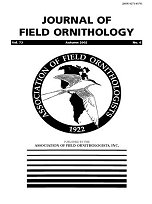I constructed track-plates resembling short pine branches and attached them to pairs of neighboring pine trees distributed over a 1000-ha area in the Colorado Front Range. I checked track-plates after four and eight days between 24–31 August 2000 and scored each for the presence or absence of tracks. Half of all track plates were marked within four days. I found a positive correlation between scores of paired trees, indicating that track-plating accurately reflected the relative abundance of birds among habitat patches. A power analysis showed that to test for a 15% difference in bird visitation among habitats with a power of 0.75 required a sample size of 25 trees.
How to translate text using browser tools
1 October 2002
Quantifying avian habitat use in forests using track-plates
Kailen A. Mooney
ACCESS THE FULL ARTICLE
It is not available for individual sale.
This article is only available to subscribers.
It is not available for individual sale.
It is not available for individual sale.

Journal of Field Ornithology
Vol. 73 • No. 4
October 2002
Vol. 73 • No. 4
October 2002
Parus
ponderosa pine
relative abundance
Sitta




